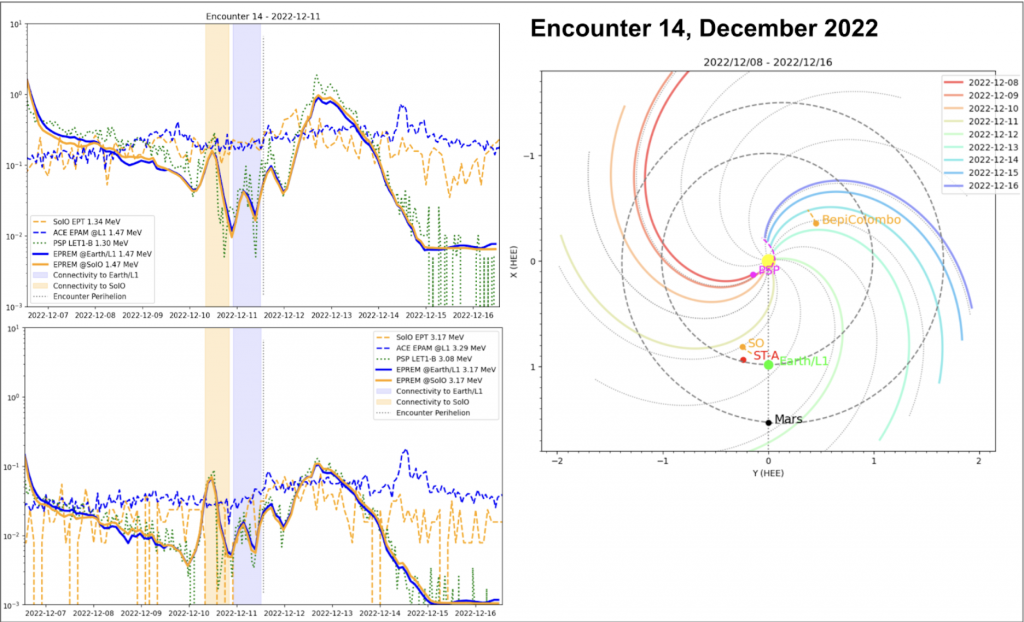After the redesign of the EPREM model, we have applied it to study inner heliospheric energetic particle transport. The source population of particles is a crucial yet very poorly constrained parameter in global solar energetic particle simulations. This is due to the lack of in situ measurements close to the Sun, where the suprathermal particle populations have not yet been modified by acceleration and transport effects in the interplanetary environment of the heliosphere. The two main identified populations of SEP particle sources are ambient coronal suprathermals and suprathermals impulsively pre-accelerated in flares. In this work, we investigated the former. We have performed for the first time to our knowledge a global study simulating with EPREM quiet-time in situ suprathermal ion measurements by the Parker Solar Probe from the Sun to 1 AU. The observations were taken during PSP’s solar perihelion encounters as inner boundary input source populations for our global particle transport simulations with a solar wind description given by a magnetohydrodynamics around a sphere (MAS) heliospheric model simulation for the specific time period. We compared the EPREM results to in situ measurements near 1 AU in order to optimize the model transport parameters. The goal was to investigate how quiet-time suprathermal ion populations are modified in a realistic heliospheric environment during a relatively quiet period, and to assess the applicability of such a diagnostic approach in near-real time space weather forecasting simulations.

Figure 1 shows a brief overview of the modeling setup for one of the PSP close encounter periods we considered. The top two panels show the magnitude of magnetic field (left) and solar wind speed (right) in the equatorial plane of the domain between the Sun and 1 AU. The PSP trajectory is shown by a parabolic arc with the current PSP position, while the model inner boundary is shown as a circle. The Earth/L1 and Solar Orbiter (SO) positions are also marked – Solar Orbiter was quite close to the Earth during this period. The inner boundary of the models is shown as a circle at 30 Rs. Since the elliptic PSP trajectory crosses the inner boundary, we had to assume a scaling for the observed particle fluxes (shown for two energy channels on the bottom panel of Fig. 1) to the circular inner boundary at all times. We chose initially to use a simple flux-conserving inverse square dependence on distance from the Sun. The scaled observed proton fluxes at all energy channels between 0.1 and 10 MeV were used to construct a time-dependent inner boundary that was assumed the same over the entire inner boundary at any given time. The fluxes were then transported out to 1 AU within the EPREM model assuming a scattering mean free path of 0.1 AU (energy-dependent), and compared with ACE and Solar Orbiter observations.
The results for the period from Fig. 1 are shown in Figure 2. On the left panels are shown observed and modeled time series for 1.34 MeV (top) and 3.17 Mev (bottom) proton energy fluxes. The plots show PSP observations (green dotted lines), the EPREM model results (solid blue and yellow lines), as well as 1 AU observations by the ACE spacecraft (blue dashed lines) and Solar Orbiter (yellow dashed lines). The yellow and light blue shadings show the periods of good nominal connectivity to Solar Orbiter and the ACE spacecraft at L1. The PSP positions in the equatorial plane on individual days and their nominal magnetic field connectivities to the inner heliosphere are shown on the right panel.

We have found that it is very difficult to find truly quiet periods with high-quality PSP observations, as 1) PSP instruments are mostly sensitive to active periods with relatively high fluxes; 2) the heliospheric environment is frequently disturbed by transient events. We find relatively good agreement between the model output and the observations. However, for part of the period the PSP fluxes are actually lower than the 1 AU ones. This may be due to issues with PSP data calibration, or it may point to interplanetary enhancement of the suprathermal fluxes – a hitherto unexplored scenario. The EPREM model reproduces well the PSP fluxes at 1 AU under the assumption of a quiet background, but this idealized state is rarely the case in reality, as the environment is often excited by transient phenomena such as coronal mass ejections (CMEs) or corotating interaction regions (CIRs), which cause flux increases. This will be explored in future work in detail.
